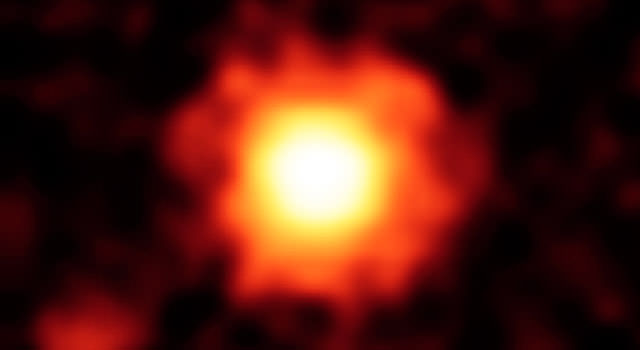

NASA’s Spitzer Space Telescope captured this infrared image of a giant halo of very fine dust around the young star HR 8799. Image credit: NASA/JPL-Caltech/Univ. of Ariz.
Just what is going on over at the star HR 8799? The place is a mess! But we can just blame it on the kids. Young, hyperactive planets circling the star are thought to be disturbing smaller comet-like bodies, causing them to collide and kick up a huge halo of dust. HR 8799 was in the news in November 2008, for being one of the first with imaged planets. Now, NASA’s Spitzer Space Telescope has taken a closer look at this planetary system and found it to be a very active, chaotic and dusty system. Ah, youth: our solar system was likely in a similar mess before our planets found their way to the stable orbits they circle in today.
The Spitzer team, led by Kate Su of the University of Arizona, Tucson, says the giant cloud of fine dust around the disk is very unusual. They say this dust must be coming from collisions among small bodies similar to the comets or icy bodies that make up today’s Kuiper Belt objects in our solar system. The gravity of the three large planets is throwing the smaller bodies off course, causing them to migrate around and collide with each other. Astronomers think the three planets might have yet to reach their final stable orbits, so more violence could be in store. The planets around HR 8799 are about 10 times the mass of Jupiter.
“The system is very chaotic and collisions are spraying up a huge cloud of fine dust,” said Su. “What’s exciting is that we have a direct link between a planetary disk and imaged planets. We’ve been studying disks for a long time, but this star and Fomalhaut are the only two examples of systems where we can study the relationships between the locations of planets and the disks.”
When our solar system was young, it went through similar planet migrations. Jupiter and Saturn moved around quite a bit, throwing comets around, sometimes into Earth. Some say the most extreme part of this phase, called the late heavy bombardment, explains how our planet got water. Wet, snowball-like comets are thought to have crashed into Earth, delivering life’s favorite liquid.
The Spitzer results were published in the Nov. 1 issue of Astrophysical Journal. The observations were made before Spitzer began its “warm” mission and used up its liquid coolant.
Source: JPL
We reported before about a NIAC-funded project known as the Lofted Environment and Atmospheric Venues…
The InSight Lander arrived on Mars in 2018 to study the planet's interior. Its mission…
It has been thought that the existence of plate tectonics has been a significant factor…
At the end of 2023, there were more than 5,000 satellites orbiting Earth, with 10s…
Of all the unanswered questions in modern science, perhaps the most talked about is whether…
On July 14th, 2015, the New Horizons probe made history by accomplishing the first flyby…